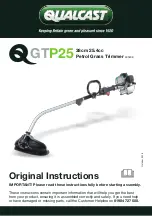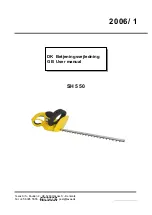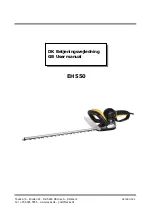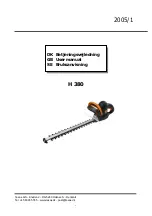
4
6. Plan your work schedule to spread any high vibration tool
use across a longer period of time.
Emergency
Familiarize yourself with the use of this product by means
of this instruction manual. Memorize the safety directions
and follow them to the letter. This will help to prevent risks
and hazards.
1. Always be alert when using this product, so that you can
recognize and handle risks early. Fast intervention can
prevent serious injury and damage to property.
2. Switch off and remove the batteries if there are
malfunctions. Have the product checked by a qualified
professional and repaired, if necessary, before you operate
it again.
Residual Risks
Even if you are operating this product in accordance with all
the safety requirements, potential risks of injury and damage
remain. The following dangers can arise in connection with the
structure and design of this product:
1. Health defects resulting from vibration emission if the
product is being used over long periods of time or not
adequately handled and properly maintained.
2. Injuries and damage to property due to broken cutting
attachments or the sudden impact of hidden objects
during use.
3. Danger of injury and property damage caused by
flying objects.
m
WARNING!
This product produces an electromagnetic
field during operation. This field may under some
circumstances interfere with active or passive medical
implants! To reduce the risk of serious or fatal injury, we
recommend persons with medical implants to consult their
doctor and the medical implant manufacturer before operating
this product.
Battery & Charger
Safety Instructions
NOTE: This unit is the tool only. The batteries and the charger
are not included. They must be purchased separately.
Model 24V-X2-24HT-CT-RM is compatible with the 24V
iON+ System batteries and chargers. See page 15 for more
information.
We pay a great deal of attention to the design of every battery
pack to ensure that we supply you with batteries that are safe,
durable and have a high energy density. The battery cells have
a wide range of safety devices. Each individual cell is initially
formatted and its electrical characteristic curves are recorded.
This data is then used exclusively to be able to assemble the
best possible battery packs.
Despite all the safety precautions, caution must always be
exercised when handling batteries. The following points must
be obeyed at all times to ensure safe use. Safe use can only
be guaranteed if undamaged cells are used. Incorrect handling
of the battery packs can cause cell damage.
IMPORTANT! Analyses confirm that incorrect use and poor
care of high-performance batteries are the main factors
responsible for personal and/or product damage.
m
WARNING!
Use only approved replacement batteries;
other batteries may damage the hedge trimmer and cause it to
malfunction.
m
CAUTION!
To reduce the risk of injury, charge the
24V iON+ lithium-ion battery packs only in the designated 24V
iON+ lithium-ion charger. Other types of chargers present risk
of fire, personal injury and damage. Do not wire the battery
packs to a power supply plug or car cigarette lighter. Such
misuse will permanently disable or damage the battery packs.
• Avoid dangerous environments – Do not charge the
battery packs in rain, snow or in damp or wet locations.
Do not use the battery packs or charger in the presence of
explosive atmospheres (gaseous fumes, dust or flammable
materials) because sparks may be generated when inserting
or removing the battery packs, which could lead to a fire.
• Charge in a well-ventilated area – Do not block the
charger vents. Keep them clear to allow for proper
ventilation. Do not allow smoking or open flames near
charging battery packs. Vented gases may explode.
NOTE: The safe temperature range for the batteries is 41°F
– 105ºF (5°C – 40.5°C). Do not charge the batteries outside
in freezing weather; charge it at room temperature.
• Maintain charger cord – When unplugging the charger,
pull the plug, not the cord, from the receptacle to reduce the
risk of damage to the electrical plug and cord.
Never carry the charger by its cord or yank it by the cord
to disconnect it from the receptacle. Keep the cord away
from heat, oil and sharp edges. Make sure the cord will not
be stepped on, tripped over or subjected to damage or
stress when the charger is in use. Do not use the charger
with a damaged cord or plug. Replace a damaged charger
immediately.






































